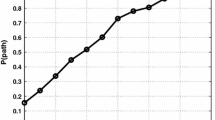Abstract
Several routing schemes have been proposed for intermittently connected wireless mobile networks. The effectiveness of these routing schemes is mostly evaluated using the metrics: messages delivered, message traffic and delay suffered by delivered messages. These metrics provide very limited evaluation of routing schemes. Even very simple and well known attributes like time and space complexity of routing schemes were not measured for evaluating the quality and applicability of routing schemes. Therefore, many significant aspects such as, resource utilization, efficiency in terms of space and time, quality of service parameters and security aspect etc. of routing schemes get overlooked. In this paper, we present the results of experimental evaluation, through simulation, of routing schemes for intermittently connected wireless mobile networks such as Delay Tolerant Network. We evaluated four routing schemes, based on different principles, namely First contact, Epidemic, Spray and wait and Dynamic Social Grouping, on parameters, such as, resource utilization, efficiency, performance and security. We found Spray and wait routing scheme performed better than others, both in terms of resource utilization and efficiency (time and space).





















Similar content being viewed by others
References
Burgess, J., Gallagher, B., Jensen, D., & Levine, B. N. (2006). Maxprop: Routing for vehicle-based disruption-tolerant networks. INFOCOM, 6, 1–11.
Burleigh, S., Hooke, A., Torgerson, L., Fall, K., Cerf, V., Durst, B., et al. (2003). Delay-tolerant networking: An approach to interplanetary internet. Communications Magazine, IEEE, 41(6), 128–136.
Cabaniss, R., Bridges, J. M., Wilson, A., & Madria, S. (2011). Dsg-n 2: A group-based social routing algorithm. In Wireless communications and networking conference (WCNC), 2011 IEEE, pp. 504–509. IEEE.
Cabaniss, R., Madria, S., Rush, G., Trotta, A., & Vulli, S. S. (2010). Dynamic social grouping based routing in a mobile ad-hoc network. In 2010 International conference on high performance computing (HiPC), pp. 1–8. IEEE.
Campista, M. E. M., Esposito, P. M., Moraes, I. M., Costa, L. H. M. K., Duarte, O. C. M. B., Passos, D. G., et al. (2008). Routing metrics and protocols for wireless mesh networks. Network, IEEE, 22(1), 6–12.
Costa, P., Mascolo, C., Musolesi, M., & Picco, G. P. (2008). Socially-aware routing for publish-subscribe in delay-tolerant mobile ad hoc networks. IEEE Journal on Selected Areas in Communications, 26(5), 748–760.
Daly, E. M., & Haahr, M. (2007). Social network analysis for routing in disconnected delay-tolerant manets. In Proceedings of the 8th ACM international symposium on mobile ad hoc networking and computing, pp. 32–40. ACM.
Hui, P., Crowcroft, J., & Yoneki, E. (2011). Bubble rap: Social-based forwarding in delay-tolerant networks. IEEE Transactions on Mobile Computing, 10(11), 1576–1589.
Jain, S., Fall, K., & Patra, R. (2004). Routing in a delay tolerant network, Vol. 34. New York: ACM.
Jiang, S., He, D., & Rao, J. (2001). A prediction-based link availability estimation for mobile ad hoc networks. In INFOCOM 2001. Twentieth annual joint conference of the IEEE computer and communications societies. Proceedings. IEEE, Vol. 3, pp. 1745–1752. IEEE.
Jiang, S., He, D., & Rao, J. (2005). A prediction-based link availability estimation for routing metrics in manets. IEEE/ACM Transactions on Networking, 13(6), 1302–1312.
Johari, R., Gupta, N., & Aneja, S. (2013). Cacbr: Context aware community based routing for intermittently connected network. In Proceedings of the 10th ACM symposium on Performance evaluation of wireless ad hoc, sensor, & ubiquitous networks. New York: ACM, pp. 137–140.
Johari, R., Gupta, N., & Aneja, S. (2013). Dsg-pc: Dynamic social grouping based routing for non-uniform buffer capacities in dtn supported with periodic carriers. In Quality, reliability, security and robustness in heterogeneous networks. New York: Springer, pp. 1–15.
Keränen, A., Ott, J., & Kärkkäinen, T. (2009). The ONE simulator for DTN protocol evaluation. In SIMUTools ’09: Proceedings of the 2nd international conference on simulation tools and techniques. New York, NY, USA: ICST.
Kim, S., Lee, O., Choi, S., & Lee, S. J. (2011). Comparative analysis of link quality metrics and routing protocols for optimal route construction in wireless mesh networks. Ad Hoc Networks, 9(7), 1343–1358.
Lindgren, A., Doria, A., & Schelen, O. (2004). Probabilistic routing in intermittently connected networks. In Service assurance with partial and intermittent resources. New York: Springer, pp. 239–254.
Musolesi, M., & Mascolo, C. (2009). Car: Context-aware adaptive routing for delay-tolerant mobile networks. IEEE Transactions on Mobile Computing, 8(2), 246–260.
Scott, J., Gass, R., Crowcroft, J., Hui, P., Diot, C., & Chaintreau, A. (2006). CRAWDAD trace cambridge/haggle/imote/intel (v. 2006-01-31).
Shaikh, A., Rexford, J., & Shin, K. G. (2001). Evaluating the impact of stale link state on quality-of-service routing. IEEE/ACM Transactions on Networking (TON), 9(2), 162–176.
Spyropoulos, T., Psounis, K., & Raghavendra, C.S. (2005). Spray and wait: An efficient routing scheme for intermittently connected mobile networks. In Proceedings of the 2005 ACM SIGCOMM workshop on delay-tolerant networking. New York: ACM, pp. 252–259.
Spyropoulos, T., Psounis, K., & Raghavendra, C.S. (2007). Spray and focus: Efficient mobility-assisted routing for heterogeneous and correlated mobility. In Fifth annual IEEE international conference on pervasive computing and communications workshops, 2007. PerCom workshops’ 07., pp. 79–85. IEEE.
Vahdat, A., & Becker, D. (2000). Epidemic routing for partially connected ad hoc networks. Tech. rep., Technical Report CS-200006, Duke University.
Vu, L., Do, Q., & Nahrstedt, K. (2010). Comfa: Exploiting regularity of people movement for message forwarding in community-based delay tolerant networks.
Zhao, L., Al-Dubai, A. Y., & Min, G. (2011). An efficient neighbourhood load routing metric for wireless mesh networks. Simulation Modelling Practice and Theory, 19(6), 1415–1426.
Zhao, W., Ammar, M., & Zegura, E. (2004). A message ferrying approach for data delivery in sparse mobile ad hoc networks. In Proceedings of the 5th ACM international symposium on mobile ad hoc networking and computing. New York: ACM, pp. 187–198.
Author information
Authors and Affiliations
Corresponding author
Rights and permissions
About this article
Cite this article
Johari, S.R., Gupta, N. & Aneja, S. Experimental Evaluation of Routing Schemes for Intermittently Connected Wireless Mobile Networks. Wireless Pers Commun 87, 897–921 (2016). https://doi.org/10.1007/s11277-015-3109-4
Published:
Issue Date:
DOI: https://doi.org/10.1007/s11277-015-3109-4




